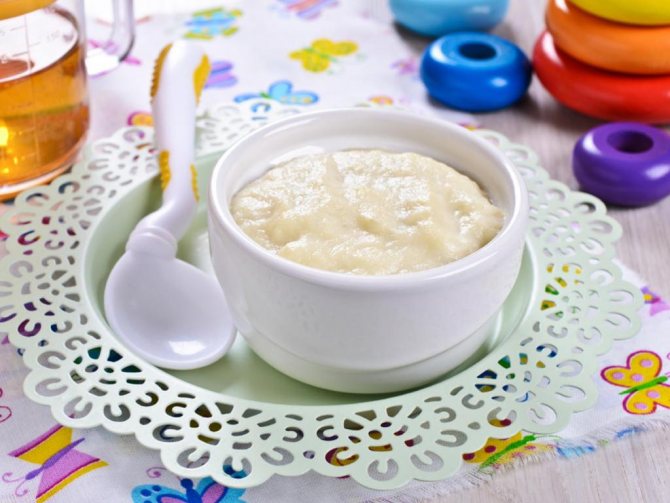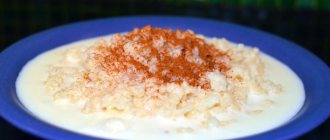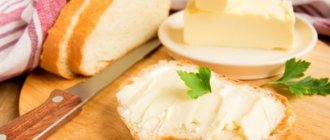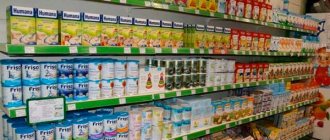| Place | Name | Characteristics in the rating |
| The best hypoallergenic dairy-free cereals for first feeding |
| 1 | Fleur Alpine | Best quality |
| 2 | Nestlé | The most popular |
| 3 | HEINZ | Recommendation from pediatricians |
| 4 | BEBI | Improved composition |
| 5 | VINNIE with prebiotics | Best price |
| The best milk porridges for first feeding |
| 1 | Kabrita | The best first feeding using an adapted goat milk formula |
| 2 | BIBIKOL MILK | Environmentally friendly product |
| 3 | Semper | High quality. Selected raw materials |
| 4 | Mamako | Reduces the number of regurgitations, eliminates colic |
| 5 | UMNITA MILK OATH WITH BANANA | Inexpensive, healthy and tasty |
| The best cereals for first feeding, ready to eat |
| 1 | HiPP | The best combination of price and quality |
| 2 | Agusha milk-buckwheat Go to sleep | Finished product in convenient packaging |
| 3 | Sami with mustache milk rice | Pleasant creamy taste, contains inulin |
| 4 | FrutoNanny | The best porridge before bed |
| 5 | When I grow up | Pleasant taste. Does not contain sugar |
The best hypoallergenic dairy-free cereals for first feeding
Any new product in a baby’s diet poses a risk of developing an allergic reaction. That is why they begin the injection with a minimum volume, literally 0.5 teaspoon, and carefully monitor the child’s well-being. The volume increases within 7-10 days. The appearance of itching and red spots on the body is not a good sign.
To reduce the likelihood of allergies, many parents prefer hypoallergenic cereals. And for those whose children have increased sensitivity and have already had precedents of this kind, a hypoallergenic menu is a must.
When is it better to introduce porridge and in what order?
It is recommended to include cereal dishes in a child’s diet 3-4 weeks after he has already become acquainted with the first complementary foods, vegetables, and is completely accustomed to them. But sometimes porridge can precede them. For example, a pediatrician may prescribe this product if the baby is not gaining enough weight or has problems with stool (with a tendency to liquefy). In any case, it is better to adhere to a certain sequence of introducing porridge into the children's menu, which the pediatrician will tell you about.
Video: Where to start complementary feeding Author: pediatrician, Ph.D. Komarovsky E.O.
6–7 months.
Which porridge should be introduced first? To begin with, you can introduce your baby to gluten-free porridge: buckwheat, rice, corn. Gluten is a gluten from vegetable protein, which can cause difficulties in digesting food in children in the first six months of life (and even a little longer). This is due to insufficient production in the gastrointestinal tract of the enzyme peptidase, which is necessary for the normal processing of gluten. The consequences of this can be bloating and pain in the tummy, increased gas production. In very rare cases, celiac disease occurs. This is a hereditary disease that results in gluten intolerance throughout life. The first cereals for children should certainly be dairy-free and mono-component, consisting of one type of cereal. They should not contain any additional components (salt, sugar, honey, fruit, berry, creamy fillers).
7–8 months.
Add oatmeal to your little one's diet as a new food item. If the child’s body tolerates familiar cereals well, combine different types of cereals with each other. It is still not recommended to cook the dish with cow's milk. At this age, you can try adding toppings to the porridge, such as applesauce.
9–10 months.
At this age, you can offer your baby wheat or barley porridge.
Cereals can also be used as a side dish, mixed with vegetable and meat complementary foods, and also as one of the components of a light children's soup. From 12 months.
From the age of one year, but not earlier, it is recommended to introduce milk porridges cooked with whole cow's milk. Provided that the baby is not allergic to this product. Also at this age you can already offer your baby to try semolina porridge.
The best manufacturers of cereals for first feeding
In the domestic market in the segment of baby cereals suitable for first feeding, the leading positions are occupied by the following manufacturing companies:
- Heinz is an American food company that has been operating in Russia since 1993. Our own baby food production plant is located in the Stavropol Territory. The products are of high quality and are in great demand among consumers.
- Nestlé is a Swiss food company. The Nestlé representative office in Russia has been operating since 1995. The baby food plant and the Bystrov factory are located in Vologda. Nestlé cereals are characterized by a pleasant taste and safe composition, which makes the brand one of the most popular.
- JSC PROGRESS is a Russian manufacturing company that has been producing one of the leading baby food brands in Russia, FrutoNyanya, since 2000. The high-tech plant is located in the Lipetsk region. FrutoNyanya porridges have a good consistency and high quality, and an acceptable pricing policy allows them to push out more famous competitors from store shelves.
- Fleur Alpine is a line of premium natural baby food products that are created based on the principles of organic agriculture. The high price of the products narrows the target audience, however, due to the unique composition and specifics of the company, Fleur Alpin finds her client.
- (Israel) owns the Baby Sitter trademark. On the Russian market - over 20 years. The brand specializes in producing premium children's dairy-free cereals.
Among those gaining popularity, it is worth noting the Slovenian one, which has been focusing on the production of premium products for feeding children for the past 35 years. Also worthy of attention are the Sibay ZAO “Products of Trans-Urals” with “Vinny” porridges, and “Umnitsa” from the Ivanovo baby food plant.
baby cereals test purchase
When choosing baby food, you need to be extremely picky. What’s especially nice is that there are independent programs that test well-known food products and give an independent assessment of the range presented. But, of course, you shouldn’t forget about your instincts. Be sure to pay attention to the packaging and expiration date, listen to the reviews of other parents, but also trust yourself. And don’t forget that you can also save on baby food! Our article will talk about this.
The content of the article:
Test purchase of baby food for babies
2008
year, in the well-known “Test Purchase” program, several samples of baby food were examined in the “
Chicken Puree
” category. Samples of puree from the brands “Beech Nut”, “Gerber”, “Hipp”, “Frutonyanya”, “Nestle”, “Agusha” were presented to the public and expert jury. The winner of the program was a sample of Beech Nut puree; all other purees contain starch.
The average price in Russia for poultry puree for feeding children is 34.70 rubles.
2009
year, as part of the “Test Purchase” program, an examination
of chamomile tea (granulated)
for children’s nutrition was carried out. The competition included products from the brands “Hipp”, “Bebi premium”, “Tema Tip-Top”, “Dania”, “Nutricia”. The winners of the program in many respects were teas for babies of the Nutricia and Hipp brands.
The average price in Russia for granulated chamomile tea for children is 143 rubles.
2009
year, the “Test Purchase” program conducted an examination
of milk rice porridge
for feeding babies of the brands “Agusha”, “Vinnie”, “Bebi”, “Heinz”, “Malyshka”, “Hipp”.
Experts have determined that in the porridges “Agusha” and “Malyshka” there are lumps left after stirring; the porridges “Hipp” and “Vinnie” have an unexpressed taste of rice. Thus, the winners
among all samples
were rice porridges of the Bebi and Heinz brands
.
The average price in Russia for rice milk porridge for babies is 76.50 rubles.
In April 2011
The Test Purchase program began examining
turkey puree
for infant nutrition. The competition included products from the brands “Gerber”, “Tema”, “Agusha”, “Frutonyanya”, “Heinz”, “Babushkino Lukoshko”. The winner of the competition was a sample of turkey puree from the “Babushkino Lukoshko” brand - this product does not contain starch, as in other samples, but rice - this is much better for feeding small children because it is easily digestible.
IN 2011
year, the “Test Purchase” program conducted a public and expert examination of applesauce samples for infant nutrition among the well-known brands “Tema”, “Gerber”, “Frutonyanya”, “Vinny”, “Nutricia”. The people's jury recognized the applesauce "Agusha" as the best. Experts also monitored the composition of the submitted samples. Starch was found in Winnie puree. The mass fraction of fruit solids turned out to be higher in the Frutonyanya puree - it became the winner of this competition.
How to save on purchases?
Perhaps the most important advice in this matter is not to buy baby “canned” food unless absolutely necessary, just because you don’t want to prepare purees and soups yourself.
§ Thrifty and caring mothers, who have enough time to cook baby cereals and purees for their babies, stop at buying only juices and fruit and vegetable purees, since they contain more vitamins, especially in winter. It is impossible to save on the quality of baby food under any circumstances, but it is quite possible to give up some of your “conveniences”.
§ Yogurt for feeding your baby can be made at home, buy a special yogurt maker - it will pay for itself very quickly, besides, homemade yogurt made without preservatives, only from natural products, will be much healthier for the child.
§ You can cook porridge for your child yourself - fortunately, there are various quick-cooking cereals in stores. After cooking, this porridge can be ground in a blender to be safe.
§ Opened baby food does not last long, even in the refrigerator. But it can be placed in a plastic container and frozen - the food will not lose its properties when defrosted. The same should be done with children's juices, cottage cheese, purees, and cereals.
If you liked our article and have any thoughts on this matter, share with us! It is very important for us to know your opinion!
Author: Natalie
.
https://www.colady.ru/rezultaty-nezavisimoj-programmy-kontrolnaya-zakupka-sposoby-sekonomit-na-detskom-pitanii.html#1
The best milk porridges for first feeding
Dairy products for first feeding have an incomparably higher nutritional value compared to dairy-free cereals. The optimal content of proteins, fats, vitamins, calcium and mineral salts allows you to provide the baby’s growing body with all the elements necessary for proper development. To reduce the risk of an allergy to a natural product, dairy dishes should be introduced no earlier than 6-9 months. It is also recommended to use goat milk porridge in your child’s diet, which is better digestible and has a high concentration of essential amino acids.
Classification of cereals

Today there is a huge variety of cereal crops. Therefore, before we talk about when to introduce milk porridge to a baby, let's understand their varieties. An approximate classification is as follows:
- dairy-free - intended for feeding babies who have individual lactose intolerance or suffer from any intestinal infections;
- dairy - intended to be introduced into the diet after dairy-free porridges;
- gluten-containing cereals, which can be fed at the 18th month of life;
- gluten-free - used as complementary food in the initial stages of transferring children to natural feeding;
- dry - classic porridges that require cooking;
- instant - instant cereals that do not require cooking;
- muesli for children - available with various additives and designed for nine-month-old babies;
- Wellings are liquid porridges sold in bottles. They are well absorbed and contribute to better adaptation to natural food.
If you do not have the slightest idea about when to introduce milk cereals to your child, and you also do not know what type of product is best to choose, then it is better to consult with a qualified specialist. He will answer all your questions in detail and help you choose the most suitable feeding system that matches the anatomical characteristics and physical development of your child.
The best cereals for first feeding, ready to eat
Despite the fact that baby cereals in packages already minimize cooking time, there is no limit to perfection. So on the shelves you can find porridges already ready for consumption. This can be porridge in jars that you can take with you on a long walk or on a trip. You can also find a product in cardboard packaging, designed for one feeding, and does not require additional dilution and cooking.
This format allows you not to waste time in the morning preparing breakfast for your child and is especially convenient if you are away from home while feeding your baby.
How to introduce complementary foods with porridge?
Complementary feeding with porridge should be introduced gradually and alternately: you should not offer your child several different porridges per day or per week.
It is necessary to introduce complementary foods in fractions, starting not with a whole plate or bottle of porridge, but with 1-2 spoons, increasing the volume of porridge offered daily. While giving this small portion, you will need to supplement your baby with breast milk or formula. Gradually, you will replace one daily breastfeeding or formula feeding with a serving of porridge: this replacement period will take approximately 1-2 weeks while the baby gets used to the introduced complementary foods.
When your child gradually adapts to single-ingredient porridge, you can gradually offer him porridges containing two, three or more grains, as well as fruits and vegetables. For children prone to allergic reactions, it is better to give monocomponent, gluten-free and dairy-free cereals.










